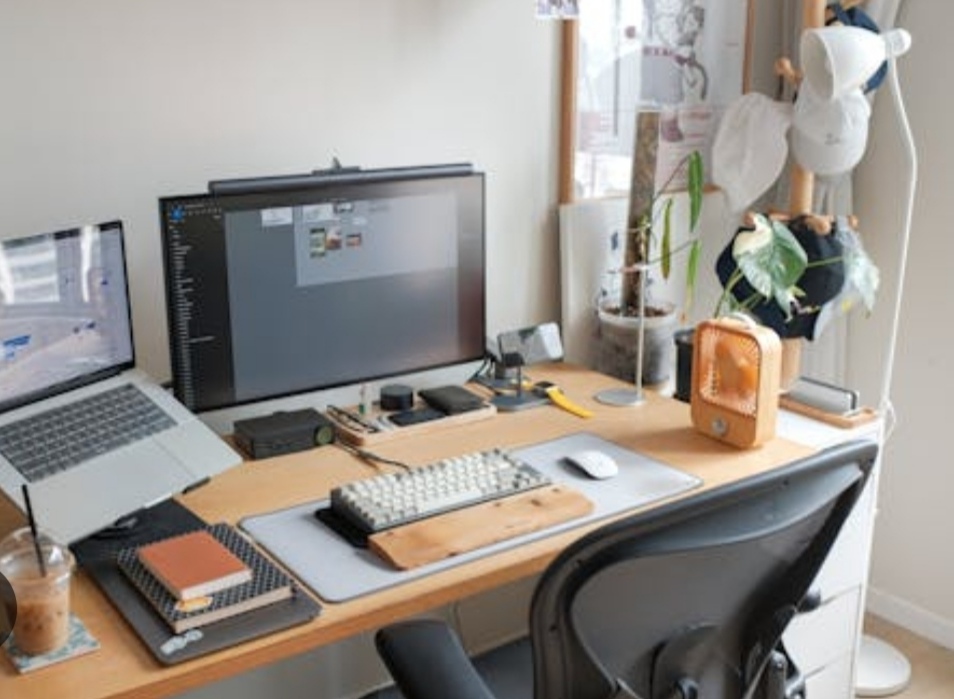In today’s world, where remote work has become the norm, having the right monitor for your home office setup isn’t just a luxury—it’s a necessity.
Whether you’re a graphic designer who needs vibrant colors, a coder juggling multiple windows, or a professional handling spreadsheets and video calls, the right monitor can dramatically elevate your productivity, reduce fatigue, and make your workday much more enjoyable.
Selecting one of the best monitors for home office setups goes beyond just choosing a screen—it’s about finding a device that meets your unique needs and enhances your overall comfort.
From ultrawide screens for multitasking to 4K monitors for crystal-clear visuals, today’s options are vast and tailored to every profession and budget.
Why It Matters
Imagine spending 8–10 hours a day staring at a subpar monitor.
The wrong monitor not only hampers your workflow but can also lead to issues like eye strain, headaches, and poor posture.
On the other hand, a well-chosen monitor with ergonomic adjustability and blue-light-reduction technology can significantly boost your focus and ensure that long workdays don’t take a toll on your health.
What This Blog Covers
In this comprehensive guide, we’ll dive into every detail you need to know about choosing the best monitors for home office use. You’ll discover:
- The key factors to consider, such as screen size, resolution, and ergonomic features.
- A list of top-rated monitors tailored for different needs and budgets.
- Insights into the latest technologies like curved screens, USB-C connectivity, and flicker-free displays.
- Actionable tips for optimizing your monitor setup for maximum productivity and comfort.
- Answers to frequently asked questions to make your buying decision effortless.
If you’ve been searching for the ultimate resource on home office monitors, this is it. Keep reading to make an informed choice and transform your home office into a productivity powerhouse.
Pro Tip: Your monitor is the cornerstone of your workspace. A well-chosen one can eliminate distractions, improve multitasking, and even add a touch of sophistication to your home office setup.
Why Choosing the Right Monitor Matters
When it comes to creating a home office setup that enhances your work experience, selecting one of the best monitors for home office use is crucial.
A thoughtfully chosen monitor can have a transformative impact on your productivity, health, and overall satisfaction during long hours of work. Here’s why it matters:
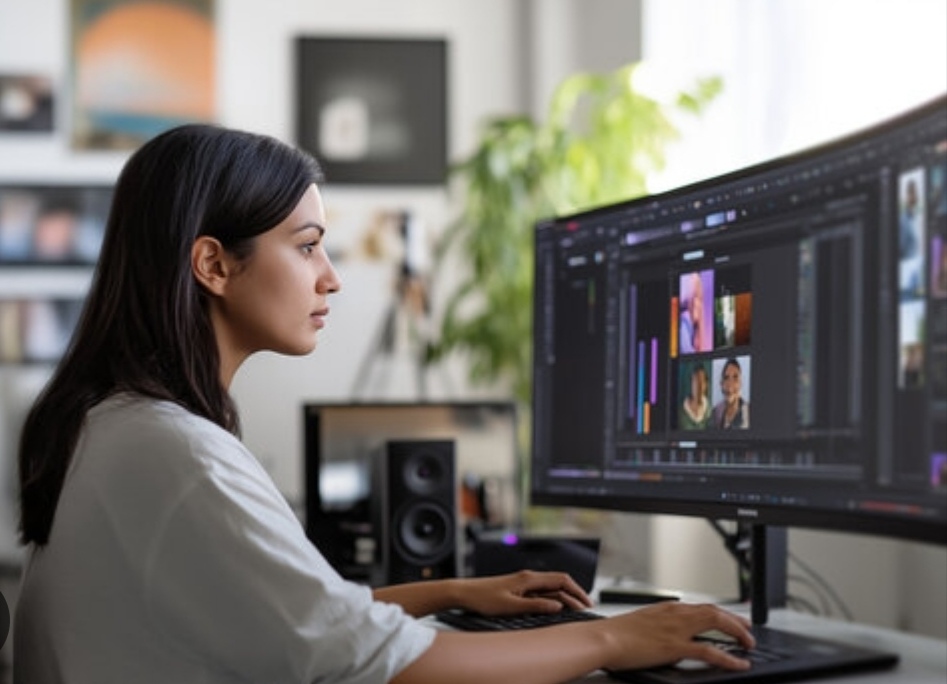
Increased Productivity for Multitasking
In a world where multitasking has become second nature, the right monitor can significantly improve how efficiently you handle multiple tasks.
Monitors with ultrawide screens or dual-monitor setups allow you to keep multiple applications or documents open side-by-side without switching back and forth.
This streamlined workflow is a game-changer for:
- Project managers juggling email, video calls, and reports.
- Programmers working on code while referencing documentation.
- Content creators editing videos or images alongside timelines and toolkits.
Monitors with higher resolutions, like 4K displays, also ensure that you can view more content on the screen without compromising clarity.
If productivity is your goal, investing in the best monitors for home office productivity will save you time and reduce frustration.
Reducing Eye Strain and Fatigue
Staring at a screen for hours can take a toll on your eyes, leading to issues like digital eye strain, blurred vision, and headaches.
Monitors equipped with eye-care technologies such as:
- Blue-light filters, which reduce harmful light exposure.
- Flicker-free technology, which minimizes screen flickering.
- Anti-glare screens, which prevent light reflection in bright environments.
These features ensure that your eyes stay comfortable throughout the day.
Additionally, adjustable monitors allow you to position the screen at the right height and angle, further alleviating neck and back strain.
By choosing one of the best ergonomic monitors for home office, you’ll create a healthier and more enjoyable workspace.
Enhancing the Quality of Visual Tasks
For professionals in creative fields like graphic design, video editing, or photography, the quality of the monitor is directly linked to the quality of their work.
High-quality monitors offer:
- Wide color gamuts and accurate color reproduction, ensuring that what you see on screen matches the final output.
- HDR capabilities, providing deeper contrast and vivid details for image and video editing.
- Higher refresh rates, which are critical for smooth video playback and animations.
Even for those not in creative professions, features like sharper resolutions and vibrant displays can make tasks like analyzing spreadsheets, reviewing presentations, and participating in video calls more engaging and enjoyable.
A crisp, clear screen reduces mental fatigue and helps maintain focus.
Why It’s Worth the Investment
While it’s tempting to settle for a budget monitor, understanding your specific needs can help you invest in a screen that delivers long-term benefits.
A poorly chosen monitor might save money upfront but could cost you in productivity, comfort, and health.
By opting for the best monitors for home office setups, you’re not just purchasing a screen—you’re creating an environment that sets you up for success.
Pro Tip: Don’t settle for less! If you’re serious about upgrading your workspace, explore monitors with cutting-edge features like USB-C connectivity, ultrawide displays, and ergonomic adjustability.
Key Factors to Consider When Choosing a Home Office Monitor
Selecting the best monitors for home office use requires understanding the features that matter most to your workflow, comfort, and budget.
Each factor plays a crucial role in ensuring your monitor complements your work style while enhancing productivity and comfort.
Let’s dive deep into the key aspects you need to evaluate.
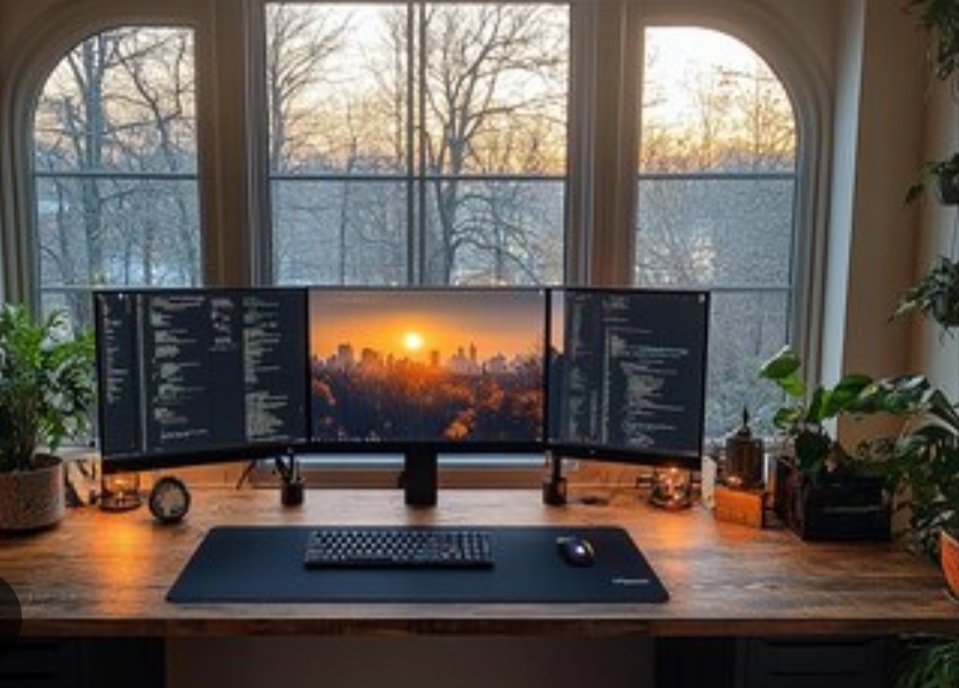
1. Screen Size and Resolution
Screen Size
The size of your monitor can drastically impact your productivity and comfort.
Choosing the right size depends on your workspace and the type of work you do. Here’s a breakdown of popular sizes:
- 24-inch monitors: Compact and affordable, ideal for small desks or straightforward tasks like writing and browsing.
- 27-inch monitors: A perfect balance between size and usability. Excellent for multitasking and professions like coding or general office work.
- 32-inch monitors: Great for creatives who need a large workspace for design or video editing.
- Ultrawide monitors (34 inches or more): A multitasker’s dream. These are perfect for trading, editing, or juggling multiple applications simultaneously without needing dual monitors.
If space isn’t an issue, a larger screen provides more room to work, reduces scrolling, and improves multitasking efficiency.
Consider investing in an ultrawide monitor if you handle complex workflows.
Resolution
Resolution determines the clarity and sharpness of your screen. Common options include:
- Full HD (1920×1080): Budget-friendly and suitable for basic office tasks.
- QHD or 2K (2560×1440): Offers sharper visuals, making it ideal for multitasking and detailed work.
- 4K (3840×2160): Provides unparalleled clarity, perfect for video editing, graphic design, and other precision tasks.
For most professionals, a 27-inch monitor with QHD resolution offers the best balance of size, clarity, and affordability.
However, for high-end visual work, a 4K monitor is worth the investment.
2. Monitor Panel Types
Monitors come with different panel types, each catering to specific needs.
Understanding these differences will help you pick a screen that aligns with your work requirements:
IPS (In-Plane Switching) Panels
- Best for: Graphic designers, photographers, and video editors.
- Why choose IPS? These panels deliver excellent color accuracy, vibrant visuals, and wide viewing angles, making them perfect for creative professionals and team collaborations.
TN (Twisted Nematic) Panels
- Best for: Gamers or users who need fast response times.
- Why choose TN? These panels boast quick response rates and are budget-friendly but lack the color depth and viewing angles of IPS panels.
VA (Vertical Alignment) Panels
- Best for: Mixed-use environments.
- Why choose VA? They provide superior contrast ratios, making them ideal for tasks that benefit from deeper blacks and better contrast, such as video playback and data analysis.
For most home office setups, IPS panels are the go-to choice for their overall balance of color and clarity.
3. Refresh Rate and Response Time
Refresh Rate
Measured in Hertz (Hz), refresh rate refers to how often the monitor updates its display per second.
- 60Hz: Standard for most home office monitors and sufficient for basic tasks.
- 120Hz or higher: Ideal for video editors or professionals handling motion-intensive work.
Higher refresh rates provide smoother visuals, which can enhance your experience during video playback or casual gaming.
Response Time
Response time measures how quickly a pixel changes from one color to another.
- Fast response times (1ms to 5ms): Essential for video editors and animators to avoid motion blur.
- Standard response times (6ms or more): Adequate for writers, coders, and general office work.
For a balanced workflow, choose a monitor with at least a 75Hz refresh rate and 5ms response time for smooth performance.
4. Ergonomics and Adjustability
Long work hours demand a monitor that supports proper posture.
Monitors with ergonomic features ensure comfort by allowing you to adjust them to your ideal position.
- Height adjustability: Prevents neck strain by aligning the screen with your eye level.
- Tilt and swivel: Helps you achieve the perfect angle and reduce glare.
- Pivot (portrait mode): Ideal for tasks like coding or reading long documents.
- VESA mount compatibility: Allows you to save desk space by mounting your monitor on a stand or wall.
Opt for ergonomic monitors to create a healthier workspace and maintain productivity during long hours.
5. Eye Comfort Features
Your monitor should prioritize eye health, especially if you’re working 8+ hours daily.
Look for the following features:
- Blue light filters: These reduce harmful blue light, which can cause eye fatigue and disrupt sleep patterns.
- Flicker-free technology: Eliminates screen flickering to prevent headaches and eye strain.
- Anti-glare screens: Perfect for reducing reflections in brightly lit rooms.
Monitors with these features are essential for maintaining comfort during extended use.
6. Connectivity Options
Modern workstations often require versatile connectivity.
Here are the most important ports to look for:
- HDMI and DisplayPort: Standard for connecting most desktops and laptops.
- USB-C: The most versatile port for transferring data, video, and power through a single cable.
- Thunderbolt: High-speed connections for creative professionals using external drives and docks.
A USB-C monitor is an excellent choice for decluttering cables and future-proofing your home office.
7. Curved vs. Flat Monitors
Curved Monitors
- Advantages: Provide an immersive viewing experience, reduce peripheral distortion, and improve focus.
- Best for: Multitaskers and users working on large spreadsheets or multiple tabs.
Flat Monitors
- Advantages: Simpler design, more practical for compact workspaces, and less expensive.
- Best for: General office use, writers, and smaller setups.
For multitasking-heavy roles, curved monitors can enhance productivity, but flat monitors remain practical for most users.
Best Monitors for Home Office: Top Recommendations
Finding the best monitors for home office setups can be overwhelming with so many options available.
To simplify your search, we’ve compiled the top recommendations for every need and budget.
Whether you’re a creative professional, a multitasker, or someone seeking a budget-friendly option, this guide has you covered.
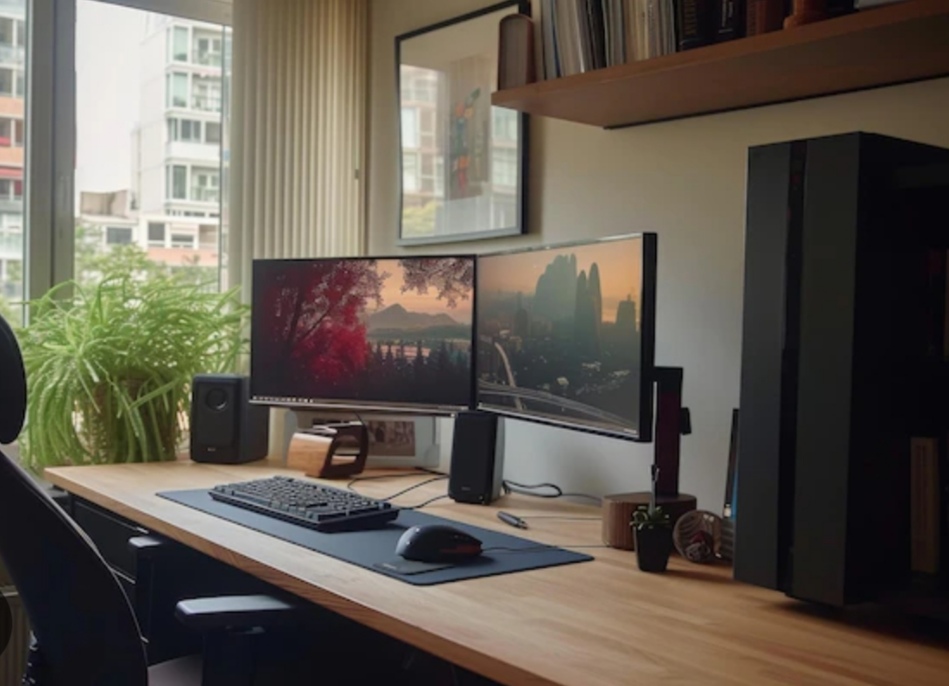
Best Overall Monitor for Home Office
Dell UltraSharp U2723QE
The Dell UltraSharp U2723QE stands out as one of the most versatile monitors for home office setups.
Its combination of superb color accuracy, modern features, and ergonomic design makes it a favorite among professionals.
- Features:
- 27-inch 4K UHD screen with IPS Black technology for vivid, lifelike colors.
- Factory-calibrated for color accuracy, covering 99% sRGB and AdobeRGB.
- Multiple connectivity options: USB-C, HDMI, DisplayPort, and USB-A ports.
- Built-in ComfortView Plus to reduce blue light emissions.
- Pros:
- Exceptional color accuracy.
- Ergonomic adjustability with height, tilt, and swivel options.
- USB-C support for single-cable convenience.
- Cons:
- Premium price point.
- No built-in speakers.
Why it’s the best:
The Dell UltraSharp U2723QE offers a perfect blend of performance, connectivity, and comfort, making it an excellent choice for most professionals looking for the best monitors for home office.
Shop now for Dell UltraSharp U2723QE
Best Budget Monitor for Home Office
Acer R240HY
If you’re looking for an affordable monitor that doesn’t compromise on quality, the Acer R240HY is a great pick.
This budget-friendly monitor offers a sleek design and solid performance, perfect for general office tasks.
- Features:
- 24-inch Full HD IPS display with wide viewing angles.
- Ultra-thin bezels for a near-borderless experience.
- Blue light filter and flicker-free technology.
- Pros:
- Affordable price.
- Crisp and clear visuals.
- Ideal for basic office tasks like spreadsheets, emails, and browsing.
- Cons:
- Limited adjustability (no height adjustment).
- Not suitable for high-end creative work.
Why it’s the best budget choice:
With its sleek design and excellent value for money, the Acer R240HY is perfect for users seeking the best monitors for home office without breaking the bank.
Best 4K Monitor for Creative Professionals
LG 32UN880-B Ergo 4K UHD Monitor
Creative professionals need a monitor that delivers outstanding color accuracy and sharpness.
The LG 32UN880-B is designed with creatives in mind, offering excellent performance and ergonomic adjustability.
- Features:
- 32-inch 4K UHD screen with HDR10 for brilliant visuals.
- 95% DCI-P3 color gamut for vibrant and accurate colors.
- Ergonomic arm mount for flexible positioning.
- USB-C connectivity for seamless integration with modern devices.
- Pros:
- Stunning 4K resolution for detailed design work.
- Ergonomic arm ensures maximum comfort.
- Supports HDR content for video editors.
- Cons:
- High price point.
- Larger size may not fit small desks.
Why it’s perfect for creatives:
The LG 32UN880-B provides the precision and clarity required for graphic design, video editing, and other creative tasks, making it one of the best monitors for home office use in the creative field.
Best Ultrawide Monitor for Multitasking
Samsung Odyssey G5 Ultrawide Curved Monitor
For multitaskers who need ample screen real estate, the Samsung Odyssey G5 is a game-changer. Its ultrawide curved design allows you to work with multiple windows simultaneously, boosting productivity.
- Features:
- 34-inch QHD curved display with a 21:9 aspect ratio.
- Quantum Dot technology for vibrant colors.
- Built-in USB-C port for easy connectivity.
- Pros:
- Immersive ultrawide design enhances multitasking.
- Excellent color reproduction for media tasks.
- Reduced eye strain due to the curved screen.
- Cons:
- May be too wide for compact desks.
- Higher price compared to standard monitors.
Why multitaskers love it:
The Samsung Odyssey G5 Ultrawide Curved Monitor is one of the best monitors for home office setups where multitasking is essential, providing a seamless and immersive experience.
Check out the Samsung Odyssey G5 Ultrawide Curved Monitor
Best Portable Monitor for Flexibility
ASUS ZenScreen MB16AC
If you need a portable monitor that offers flexibility and performance, the ASUS ZenScreen MB16AC is a standout option. It’s ideal for professionals who work on the go or in limited spaces.
- Features:
- 15.6-inch Full HD IPS display.
- USB-C and USB-A connectivity for universal compatibility.
- Auto-rotating display for landscape and portrait modes.
- Pros:
- Lightweight and portable.
- Easy setup with plug-and-play functionality.
- Compact size fits in any workspace.
- Cons:
- Smaller screen size may not suit all tasks.
- Limited brightness compared to standard monitors.
Why it’s great for flexibility:
The ASUS ZenScreen MB16AC is a versatile and portable option for users who value flexibility in their home office monitor setup.
Discover the ASUS ZenScreen MB16AC
Finding the Best Monitor for Your Needs
Choosing the best monitor for your home office depends on your specific requirements, budget, and workspace.
Whether you’re looking for a budget-friendly option or a high-performance 4K monitor for creative work, there’s a monitor to suit every need.
Ready to upgrade your setup? Don’t wait—explore these top picks and transform your home office experience today!
Shop the best monitors for home office here.
Additional Accessories to Improve Your Home Office Monitor Setup
A functional and well-organized workspace goes beyond just choosing the best monitors for home office.
Adding the right accessories to your monitor setup can significantly enhance comfort, productivity, and aesthetics.
In this section, we’ll explore must-have accessories that can elevate your home office experience to the next level.
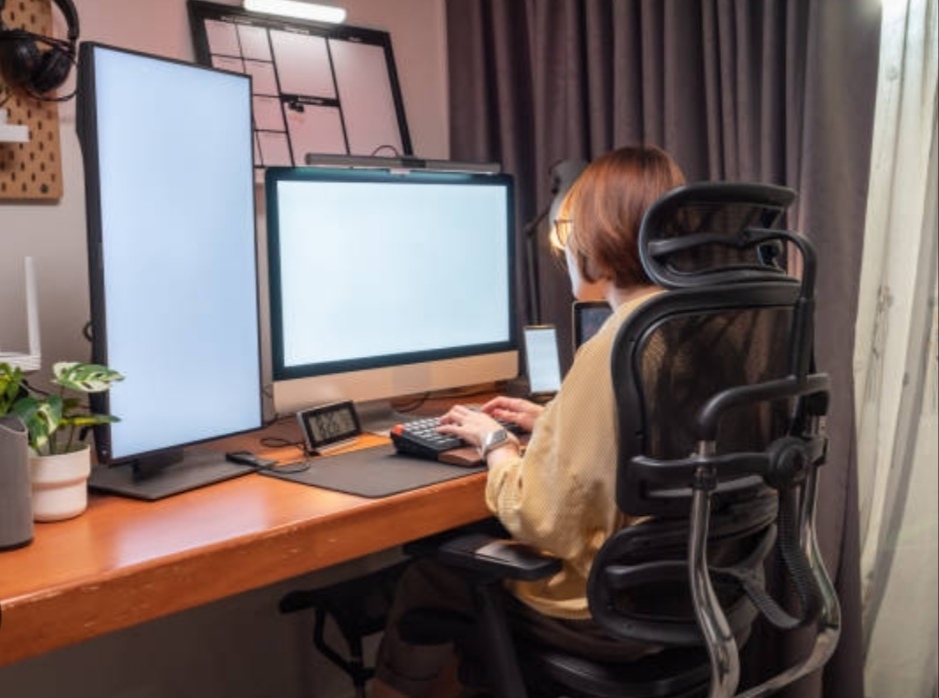
Monitor Arms for Better Adjustability
Why You Need a Monitor Arm:
Monitor arms are game-changers for those looking to maximize desk space and ensure ergonomic comfort.
They allow you to easily adjust the height, tilt, and orientation of your monitor, promoting better posture and reducing neck strain.
- Benefits of Using Monitor Arms:
- Improved ergonomics: Customize the monitor position for a comfortable viewing angle.
- Space-saving: Free up desk space by lifting the monitor off the desk.
- Clean aesthetics: Keeps your workspace organized and professional-looking.
- Best Monitor Arm Recommendations:
- Ergotron LX Desk Monitor Arm: Durable and highly adjustable, perfect for large monitors.
- AmazonBasics Premium Monitor Stand: Affordable yet sturdy for lightweight monitors.
Invest in a quality monitor arm to complement your home office monitor setup and enjoy a more productive work environment.
Laptop Stands for Dual-Screen Workflows
Maximize Your Productivity:
Adding a laptop stand is a simple yet effective way to create a dual-screen workflow.
This accessory raises your laptop to eye level, allowing seamless multitasking between your laptop and monitor.
- Benefits of Laptop Stands:
- Elevates your laptop for ergonomic viewing.
- Reduces neck and eye strain.
- Perfect for extending your screen real estate when paired with a monitor.
- Top Laptop Stands for Home Office:
- Rain Design mStand: Sleek aluminum design with a stable base.
- Nulaxy Adjustable Laptop Stand: Foldable and portable, ideal for small spaces.
For multitasking enthusiasts, pairing your monitor with a laptop stand can drastically improve your workflow and efficiency.
Docking Stations for Seamless Connectivity
Streamline Your Setup:
Docking stations are essential for those who use laptops in their home office.
They allow you to connect multiple devices, including your monitor, keyboard, mouse, and external drives, with a single cable.
- Why Docking Stations are Must-Have Accessories:
- Simplifies connectivity with one central hub.
- Supports multiple monitors and high-speed data transfers.
- Keeps your desk organized by reducing cable clutter.
- Recommended Docking Stations:
- CalDigit TS4 Thunderbolt 4 Dock: Premium option for professionals needing robust connectivity.
- Plugable USB-C Docking Station: Affordable and compatible with most laptops.
Adding a high-quality docking station is a no-brainer for anyone juggling multiple devices alongside their home office monitor.
Cable Management Solutions to Keep Your Workspace Tidy
Declutter Your Workspace:
A clutter-free workspace promotes focus and productivity.
Cable management solutions are inexpensive but impactful additions that help keep your desk organized.
- Cable Management Tools to Consider:
- Cable sleeves: Bundle multiple wires into a single sleeve.
- Cable clips: Keep frequently used cables within easy reach.
- Under-desk cable trays: Hide cables under the desk for a cleaner look.
- Why Cable Management Matters:
- Prevents tripping hazards and tangled wires.
- Enhances the aesthetics of your home office.
- Makes it easier to locate and swap cables when needed.
Take control of cable chaos with these simple solutions and enjoy a neat and professional home office setup.
Bonus Tips to Maximize Your Home Office Monitor Setup
- Invest in quality lighting: Pair your monitor with an LED desk lamp to reduce eye strain during late-night work sessions.
- Consider anti-glare screens: These can be attached to your monitor to minimize reflections and improve visibility.
- Add a standing desk converter: This accessory lets you alternate between sitting and standing, improving overall health and productivity.
Small Additions, Big Impact
Enhancing your workspace with the right accessories can make a significant difference in your daily workflow.
Whether you’re aiming for better ergonomics, improved multitasking, or a cleaner setup, these additions will take your home office to the next level.
Ready to upgrade? Shop the best accessories to pair with your home office monitor here.
With the right setup, you’ll not only boost productivity but also create a workspace you love spending time in.
Benefits of Dual-Monitor Setups for Productivity
The popularity of dual-monitor setups has soared as more people realize their immense productivity benefits.
Whether you’re working remotely, managing a side hustle, or handling complex workflows, a dual-monitor setup can transform your efficiency.
Here’s a detailed breakdown of why this setup is ideal for enhancing productivity, how to optimize it, and the best dual-monitor combinations for your needs.

Advantages of a Dual-Monitor Setup for Multitasking
1. Seamless Workflow:
A dual-monitor setup allows you to view multiple applications side-by-side without constantly switching between tabs. For instance, you can keep your email inbox open on one screen while working on a document or spreadsheet on the other.
2. Improved Focus:
With dual monitors, distractions caused by window toggling are minimized. This helps maintain focus and saves valuable time.
3. Enhanced Multitasking Capabilities:
Professionals like designers, developers, and financial analysts can leverage dual monitors to:
- Work on one project while referencing data on the other screen.
- Edit videos or photos more efficiently by keeping timelines on one monitor and tools on the other.
4. Better Collaboration:
Dual monitors make it easier to share screens during virtual meetings. You can dedicate one screen to presenting and the other to taking notes or tracking the meeting agenda.
5. Greater Comfort and Reduced Fatigue:
Switching between multiple windows on a single screen can strain your eyes. Dual monitors allow for a natural workflow that reduces eye strain and enhances ergonomics.
Incorporating dual monitors in your home office setup ensures smoother multitasking, making it one of the best ways to optimize productivity at home.
Tips for Aligning and Optimizing Dual Monitors
To get the most out of a dual-monitor setup, it’s essential to align and optimize the screens properly. Here are some practical tips to help you achieve the perfect setup:
1. Align the Monitors at Eye Level:
- Ensure both screens are at eye level to avoid neck strain.
- Use monitor arms or adjustable stands to align the monitors.
2. Use a Consistent Resolution and Refresh Rate:
- Having the same resolution on both monitors ensures a seamless transition of windows between screens.
- A refresh rate of at least 60Hz is recommended for smoother visuals.
3. Adjust the Display Settings:
- Set one monitor as the primary display for taskbars and shortcuts.
- Extend your display instead of mirroring it to maximize screen real estate.
4. Position Monitors Strategically:
- Place monitors side-by-side for general workflows.
- Use a vertical arrangement for coding or tasks requiring long scrolling.
5. Invest in Ergonomic Accessories:
- A high-quality monitor arm ensures adjustability for both screens.
- Use an anti-glare screen protector to reduce reflections, especially if your desk is near a window.
Optimizing your dual-monitor setup ensures maximum comfort and productivity, making it an essential addition to your home office.
Recommended Dual-Monitor Combinations for Efficiency
Choosing the right dual-monitor combination depends on your profession and workflow requirements.
Below are some of the best monitors for home office setups tailored for specific needs:
1. For General Office Use:
- Dell UltraSharp U2723QE: Known for its vibrant 4K resolution and wide color gamut.
- HP VH240a: A budget-friendly Full HD monitor perfect for pairing with another screen.
2. For Creative Professionals:
- LG 27UL850-W: A 27″ 4K monitor with HDR10 support for design and editing.
- BenQ PD3220U: Ideal for precise color grading and creative workflows.
3. For Multitasking Enthusiasts:
- Samsung CJ791: A 34” ultrawide monitor that pairs beautifully with a secondary vertical screen.
- ViewSonic VP3481a: Offers extensive screen real estate and incredible sharpness.
4. For Developers and Coders:
- ASUS ProArt PA32UCX: A 32” monitor designed for coding and testing applications.
- Dell P2418HT (Touchscreen): A compact yet highly functional monitor for multitasking.
5. For Financial Analysts and Traders:
- LG 34WN80C-B: A curved ultrawide monitor ideal for analyzing multiple charts simultaneously.
- Pair it with Dell 24 Monitor – P2421D for additional screen space.
Pro Tip: When selecting monitors, ensure they have the necessary connectivity ports like HDMI, DisplayPort, or USB-C for easy setup.
Check out these top dual-monitor options to find the perfect combination for your needs.
Final Thoughts on Dual-Monitor Setups
A dual-monitor setup is no longer a luxury but a necessity for anyone looking to supercharge their productivity.
Whether you’re handling complex projects or simply want a more comfortable workspace, the benefits are undeniable.
Ready to enhance your home office? Explore the best monitors for home office setups here.
With the right combination of monitors and accessories, you can create a workspace that supports your goals and keeps you at the top of your game.
Tips to Optimize Your Monitor Usage in a Home Office
Setting up the best monitors for home office is only half the battle.
To maximize productivity and comfort, you need to optimize your monitor usage. From proper placement to software tools for screen management, these tips will help you work smarter and avoid strain during long hours at your desk.
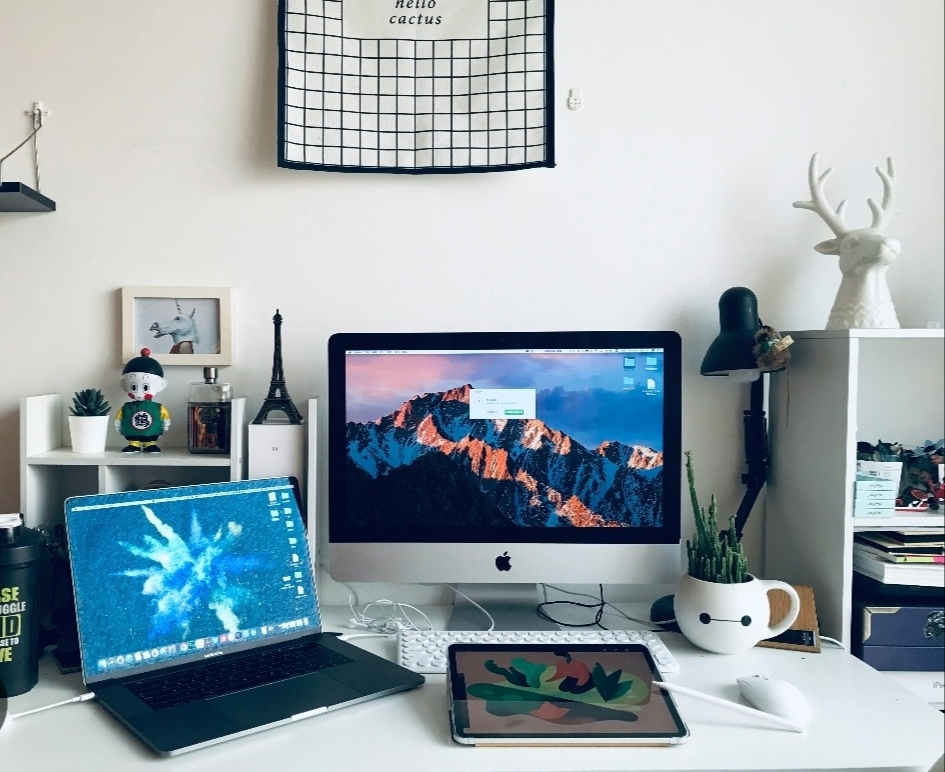
Monitor Placement for Better Ergonomics
Proper monitor placement is crucial for maintaining good posture and reducing neck and eye strain. Here’s how to position your monitor effectively:
1. Maintain the Right Distance and Height
- Distance: Keep your monitor at least 20-30 inches (about arm’s length) from your eyes. This minimizes strain while keeping the content legible.
- Height: The top edge of your monitor should align with your eye level. This ensures that your gaze naturally falls at a 15-20 degree angle downward, promoting better neck posture.
2. Position for Optimal Viewing Angles
- Your monitor should be directly in front of you, avoiding any need to turn your head.
- Tilt the screen slightly back (10-20 degrees) to reduce glare and create a comfortable viewing angle.
3. Use Ergonomic Accessories
- Monitor Arms: Adjustable monitor arms can help you achieve the ideal height and distance.
- Standing Desk: Combine a standing desk with your monitor setup to alternate between sitting and standing, reducing fatigue.
Pro Tip: Use the Rule of 20-20-20 — every 20 minutes, look at something 20 feet away for 20 seconds. This reduces eye strain significantly.
Adjusting Brightness and Color Settings
Even the best monitors for home office can cause discomfort if the brightness and color settings aren’t adjusted properly. Here’s how to fine-tune your monitor for long hours of productivity:
1. Calibrate Brightness and Contrast
- Brightness: Match your monitor’s brightness to the lighting in your room. A screen that’s too bright or dim can cause eye strain.
- Contrast: Increase the contrast to make text and images more defined, but avoid settings that are too sharp.
2. Adjust Color Temperature
- Use a warmer color temperature (yellowish tones) for late-night work to reduce blue light exposure.
- Switch to neutral or cooler tones (whitish-blue) during the day for better focus.
3. Enable Blue Light Filters
Most modern monitors come with a built-in blue light filter mode. Activating this reduces eye strain, especially during evening hours. Alternatively, use apps like f.lux to adjust the color temperature dynamically.
Quick Tip: Regularly clean your monitor screen to remove smudges or dust that can blur visuals and cause unnecessary eye strain.
Software Tools for Screen Organization
Managing multiple windows across one or more screens can be challenging. Using specialized software tools can help you organize your workspace more effectively:
1. FancyZones (Windows)
- Part of Microsoft’s PowerToys, this tool lets you create custom layouts for snapping and arranging windows.
- Ideal for multitasking, it allows you to divide your screen into zones for better workflow management.
2. Magnet (Mac)
- Magnet is a popular screen management app for macOS.
- Drag and drop windows into pre-set positions like halves, quarters, or full screen to keep your workspace organized.
3. DisplayFusion (Windows)
- Perfect for dual or multi-monitor setups, DisplayFusion offers advanced window management, monitor profiles, and customizable hotkeys.
4. Mission Control (Mac)
- Native to macOS, Mission Control gives you an overview of all open applications, allowing you to switch between them easily.
Final Thoughts on Monitor Optimization
By optimizing your monitor setup, you can dramatically improve your comfort, focus, and productivity in a home office environment.
From ergonomic adjustments to software tools, small tweaks can make a big difference in your daily workflow.
Take action today: Invest in the best monitors for home office and implement these optimization tips for a more productive and enjoyable workspace.
Whether you’re tackling demanding tasks or simply aiming to work more comfortably, these strategies will set you up for success.
Frequently Asked Questions (FAQs)
When selecting the best monitors for home office, you might have a range of questions about performance, features, and setup.
To help you make informed decisions, here are detailed answers to some of the most common questions.

What features should I look for in the best monitors for home office?
When shopping for a home office monitor, prioritize features that enhance productivity and comfort:
- Screen Size and Resolution: A 24-inch to 32-inch monitor with Full HD or 4K resolution is ideal for most tasks. Larger screens and higher resolutions improve multitasking and readability.
- Ergonomics: Adjustable stands and VESA mount compatibility allow for customized height and angle adjustments.
- Eye Comfort: Look for technologies like blue light filters and flicker-free screens to reduce eye strain during long work hours.
- Connectivity: Ensure the monitor has multiple ports (HDMI, USB-C, DisplayPort) for easy connections to laptops, desktops, or docking stations.
- Refresh Rate and Response Time: For general office work, a refresh rate of 60Hz and a response time of 5ms are sufficient. For creative professionals, higher refresh rates and color accuracy may be more critical.
Quick Tip: Consider these top-rated monitors with excellent reviews to meet your home office needs.
Are curved monitors good for home office use?
Yes, curved monitors can be a fantastic choice for home offices. They offer several benefits:
- Immersive Viewing Experience: The curved design reduces peripheral distortion, allowing you to see more of the screen without moving your head.
- Reduced Eye Strain: The natural curvature aligns with the human eye’s field of view, leading to less eye strain over extended periods.
- Ideal for Multi-tasking: Wide curved monitors, especially ultrawide ones, allow you to split screens easily for multitasking.
However, if your work involves precise tasks like graphic design, ensure the curvature does not distort your visuals.
How do I choose between a single monitor and a dual-monitor setup?
Choosing between a single and dual-monitor setup depends on your workflow and tasks:
- Single Monitor:
- Ideal for minimalists or those with space constraints.
- Choose a larger screen (27 inches or more) with high resolution to accommodate multiple windows.
- Dual Monitors:
- Perfect for multitaskers, such as programmers, writers, or data analysts.
- Allows you to have different applications on separate screens for better workflow management.
Pro Tip: Invest in a monitor arm or stand to optimize desk space for dual-monitor setups.
Can I use my TV as a monitor for my home office?
While technically possible, TVs are not the best choice for office work. Here’s why:
- Resolution and Pixel Density: Monitors have higher pixel density, making text and images sharper than TVs.
- Refresh Rates: TVs may have lower refresh rates, leading to slower performance for tasks like video editing or fast browsing.
- Ergonomics: TVs are not designed for close-up viewing, which can strain your eyes over time.
If you decide to use a TV, ensure it supports 4K resolution and has a low input lag feature.
How can I prevent glare on my monitor?
Glare can cause discomfort and reduce screen visibility. Here are some tips to minimize glare:
- Position Your Monitor: Place the monitor perpendicular to windows or light sources to avoid direct reflections.
- Use Anti-Glare Screen Protectors: These accessories can significantly reduce reflections and improve clarity.
- Adjust Lighting: Use blinds or curtains to control natural light, and position desk lamps to avoid shining directly onto the screen.
What are the benefits of using a monitor with a USB-C port?
USB-C monitors are increasingly popular due to their versatility. Here’s why they’re a great choice:
- Single Cable Solution: A USB-C cable can transmit video, audio, and power simultaneously, reducing cable clutter.
- Fast Data Transfer: USB-C supports high-speed data transfer, which is ideal for transferring files or connecting external devices.
- Compatibility: Many laptops and modern devices now support USB-C connections, making it easier to set up.
How do I maintain my monitor for long-term use?
To extend your monitor’s lifespan, follow these maintenance tips:
- Clean Regularly: Use a microfiber cloth and a screen-safe cleaner to keep your monitor dust-free.
- Avoid Prolonged Static Images: Turn on screen savers or set your monitor to sleep mode to prevent burn-in on older monitors.
- Check Connections: Regularly inspect cables for wear and ensure ports are clean to maintain stable connections.
Upcoming Trends in Monitors for Home Offices
The monitor market is rapidly evolving, driven by technological advancements and the demand for more efficient home office setups.
If you’re considering upgrading your workspace, keeping an eye on upcoming trends can help you future-proof your investment.
Below, we’ll dive into some of the most exciting innovations shaping the future of home office monitors.

Smart Monitors with Built-in Apps
A Smarter Way to Work
Smart monitors are redefining how we interact with technology in the home office.
With built-in apps and operating systems, these monitors can function independently of traditional PCs, making them a versatile option for multitaskers.
Brands like Samsung and LG are at the forefront, offering monitors that integrate seamlessly with productivity apps, streaming services, and even cloud platforms.
- Samsung Smart Monitor Series: These monitors come equipped with built-in apps like Microsoft Office 365, allowing users to edit documents or attend virtual meetings without a connected PC. They’re perfect for minimalistic setups where space is a premium.
- LG Smart Monitors: LG’s offerings include voice assistant compatibility and AI-driven display settings that adjust brightness and contrast automatically based on the environment.
How It Benefits You:
Smart monitors are ideal for professionals looking for an all-in-one solution.
They eliminate the need for multiple devices, reduce desk clutter, and simplify workflows.
USB-C and Wireless Monitors
The Future of Clean, Cable-Free Workspaces
Cable clutter is a common frustration in home offices, but USB-C and wireless monitors are changing the game. These monitors support power delivery, video transmission, and data transfer through a single cable—or none at all.
- USB-C Monitors:
- Ideal for modern laptops like MacBooks or Dell XPS models, USB-C monitors can charge your device while displaying content.
- Popular models, like the Dell UltraSharp U2723QE, offer 4K resolution, superior color accuracy, and a sleek design.
- Wireless Monitors:
- Monitors like the Lenovo ThinkVision M14t or Samsung’s wireless offerings enable screen mirroring without the hassle of cables.
- These are particularly useful for collaborative environments or for users who frequently switch between devices.
How It Benefits You:
A cleaner workspace improves focus and productivity.
Plus, USB-C and wireless monitors are often designed with energy efficiency in mind, making them a sustainable choice.
Energy-Efficient Monitors
Eco-Friendly Choices for Sustainability
As sustainability becomes a priority, many manufacturers are focusing on creating energy-efficient monitors.
These monitors not only lower electricity bills but also reduce your carbon footprint, making them a win-win for both your wallet and the environment.
- Energy Star-Certified Monitors:
- Look for models with certifications like Energy Star, which ensure that the monitor meets strict energy efficiency standards.
- Examples include the ASUS VA24DQSB, which combines eco-friendliness with excellent display quality.
- Low Power Consumption Features:
- Many modern monitors come with features like automatic brightness adjustment and power-saving modes.
- Brands like Acer and BenQ are leading in this space, offering monitors that consume minimal energy without compromising performance.
How It Benefits You:
Investing in an energy-efficient monitor is not just a cost-saving measure; it’s a step toward a more sustainable future.
Why These Trends Matter for Your Home Office
Staying ahead of technology trends ensures your home office remains efficient, future-proof, and aligned with your professional goals.
Whether you’re looking for a monitor that enhances productivity, supports sustainability, or simply reduces desk clutter, these innovations offer something for everyone.
Conclusion
Creating a productive home office setup requires thoughtful planning, and selecting the best monitors for home office is one of the most critical decisions you can make.
Your monitor is the centerpiece of your workspace, and investing in the right one can significantly improve your productivity, comfort, and overall work experience.
Key Takeaways for Choosing the Best Monitors for Home Office
After exploring the various aspects of monitor usage, here’s a summary to guide your decision-making process:
- Understand Your Needs:
Consider your daily tasks. Are you working with documents, editing videos, coding, or multitasking? For general office work, a standard monitor will suffice. For more complex tasks, consider a dual-monitor setup or an ultrawide display. - Prioritize Comfort and Ergonomics:
To avoid discomfort and health issues like neck or eye strain, focus on adjustable stands, anti-glare screens, and features like blue light filters. Optimizing the placement and brightness of your monitor is equally essential. - Choose Based on Features:
Look for monitors that offer high resolution (such as 4K), good connectivity options (like USB-C or HDMI), and features that match your workflow, such as a fast refresh rate for designers or wide viewing angles for collaborative work. - Think Long-Term:
A monitor is an investment. Consider energy-efficient models and those that come with robust warranties. This ensures your workspace stays functional and efficient for years.
Action Steps to Upgrade Your Workspace
If you’re ready to transform your home office:
- Research and Compare Models: Visit trusted review platforms to find the best monitors for home office.
- Optimize Your Setup: Pair your new monitor with the right desk accessories, such as ergonomic chairs or monitor arms.
- Maximize Productivity: Use tools like FancyZones or Magnet to organize your screen layout and minimize distractions.
Why Your Choice Matters
The right monitor isn’t just about specs—it’s about creating a workspace that aligns with your goals.
Whether you’re aiming to boost efficiency, reduce fatigue, or enjoy a more aesthetically pleasing setup, choosing the best monitors for home office can have a transformative impact.
Explore top-rated home office monitors now and make your work-from-home experience better than ever.
Your home office deserves the best, and the right monitor can be a game-changer. Don’t settle for less when your productivity and comfort are on the line. Click here to find the perfect monitor for your home office setup. Your future self will thank you!
You might also like :

